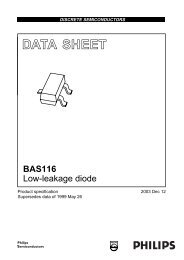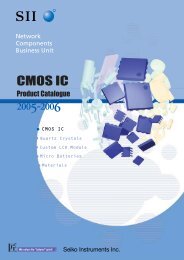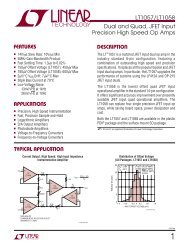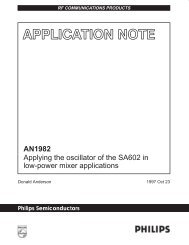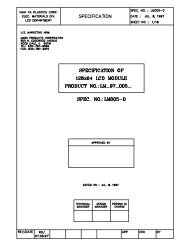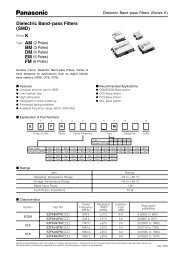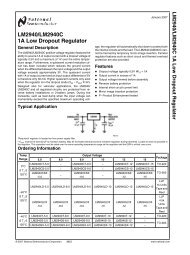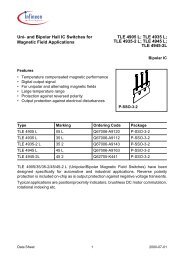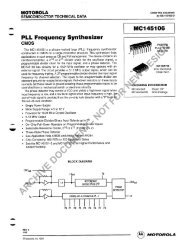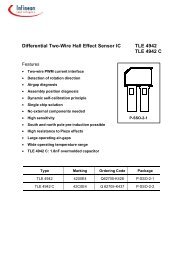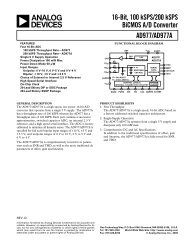SA604A - NXP Semiconductors
SA604A - NXP Semiconductors
SA604A - NXP Semiconductors
Create successful ePaper yourself
Turn your PDF publications into a flip-book with our unique Google optimized e-Paper software.
RF COMMUNICATIONS PRODUCTS<br />
<strong>SA604A</strong><br />
High performance low power FM IF<br />
system<br />
Product specification<br />
Replaces data of December 15, 1994<br />
IC17 Data Handbook<br />
1997 Nov 07<br />
Philips <strong>Semiconductors</strong>
Philips <strong>Semiconductors</strong><br />
Product specification<br />
High performance low power FM IF system<br />
<strong>SA604A</strong><br />
DESCRIPTION<br />
The <strong>SA604A</strong> is an improved monolithic low-power FM IF system<br />
incorporating two limiting intermediate frequency amplifiers,<br />
quadrature detector, muting, logarithmic received signal strength<br />
indicator, and voltage regulator. The <strong>SA604A</strong> features higher IF<br />
bandwidth (25MHz) and temperature compensated RSSI and<br />
limiters permitting higher performance application compared with the<br />
SA604. The <strong>SA604A</strong> is available in a 16-lead SO (surface-mounted<br />
miniature) package.<br />
FEATURES<br />
• Low power consumption: 3.3mA typical<br />
• Temperature compensated logarithmic Received Signal Strength<br />
Indicator (RSSI) with a dynamic range in excess of 90dB<br />
• Two audio outputs - muted and unmuted<br />
• Low external component count; suitable for crystal/ceramic filters<br />
• Excellent sensitivity: 1.5µV across input pins (0.22µV into 50Ω<br />
matching network) for 12dB SINAD (Signal to Noise and Distortion<br />
ratio) at 455kHz<br />
• <strong>SA604A</strong> meets cellular radio specifications<br />
PIN CONFIGURATION<br />
D Package<br />
IF AMP DECOUPLING 1<br />
16 IF AMP INPUT<br />
GND 2<br />
15 IF AMP DECOUPLING<br />
MUTE INPUT<br />
CC<br />
RSSI OUTPUT<br />
MUTE AUDIO OUTPUT<br />
UNMUTE AUDIO OUTPUT<br />
QUADRATURE INPUT<br />
3<br />
4<br />
5<br />
6<br />
7<br />
8<br />
14<br />
13<br />
12<br />
11<br />
10<br />
9<br />
IF AMP OUTPUT<br />
GND<br />
LIMITER INPUT<br />
LIMITER DECOUPLING<br />
LIMITER DECOUPLING<br />
LIMITER<br />
Figure 1. Pin Configuration<br />
SR00311<br />
APPLICATIONS<br />
• Cellular radio FM IF<br />
• High performance communications receivers<br />
• Intermediate frequency amplification and detection up to 25MHz<br />
• RF level meter<br />
• Spectrum analyzer<br />
• Instrumentation<br />
• FSK and ASK data receivers<br />
ORDERING INFORMATION<br />
DESCRIPTION TEMPERATURE RANGE ORDER CODE DWG #<br />
16-Pin Plastic Small Outline (SO) package (Surface-mount) -40 to +85°C <strong>SA604A</strong>D SOT109-1<br />
ABSOLUTE MAXIMUM RATINGS<br />
SYMBOL PARAMETER RATING UNITS<br />
V CC Single supply voltage 9 V<br />
T STG Storage temperature range -65 to +150 °C<br />
T A Operating ambient temperature range <strong>SA604A</strong> 40 to +85 °C<br />
θ JA Thermal impedance D package 90 °C/W<br />
1997 Nov 07 2<br />
853-1431 18663
Philips <strong>Semiconductors</strong><br />
High performance low power FM IF system<br />
Product specification<br />
<strong>SA604A</strong><br />
BLOCK DIAGRAM<br />
16 15 14 13 12 11 10 9<br />
GND<br />
IF<br />
AMP<br />
LIMITER<br />
LIMITER<br />
SIGNAL<br />
STRENGTH<br />
QUAD<br />
DET<br />
VOLTAGE<br />
REGULATOR<br />
MUTE<br />
GND<br />
V CC<br />
1<br />
2<br />
3<br />
4<br />
5<br />
6<br />
7<br />
8<br />
SR00312<br />
Figure 2. Block Diagram<br />
DC ELECTRICAL CHARACTERISTICS<br />
V CC = +6V, T A = 25°C; unless otherwise stated.<br />
LIMITS<br />
SYMBOL PARAMETER TEST CONDITIONS <strong>SA604A</strong> UNITS<br />
MIN TYP MAX<br />
V CC Power supply voltage range 4.5 8.0 V<br />
I CC DC current drain 2.5 3.3 4.0 mA<br />
Mute switch input threshold<br />
(ON)<br />
(OFF)<br />
1.7<br />
1.0<br />
V<br />
V<br />
1997 Nov 07 3
Philips <strong>Semiconductors</strong><br />
High performance low power FM IF system<br />
Product specification<br />
<strong>SA604A</strong><br />
AC ELECTRICAL CHARACTERISTICS<br />
Typical reading at T A = 25°C; V CC = ±6V, unless otherwise stated. IF frequency = 455kHz; IF level = -47dBm; FM modulation = 1kHz with<br />
±8kHz peak deviation. Audio output with C-message weighted filter and de-emphasis capacitor. Test circuit Figure 3. The parameters listed<br />
below are tested using automatic test equipment to assure consistent electrical characterristics. The limits do not represent the ultimate<br />
performance limits of the device. Use of an optimized RF layout will improve many of the listed parameters.<br />
LIMITS<br />
SYMBOL PARAMETER TEST CONDITIONS <strong>SA604A</strong> UNITS<br />
MIN TYP MAX<br />
Input limiting -3dB Test at Pin 16 -92 dBm/50Ω<br />
AM rejection 80% AM 1kHz 30 34 dB<br />
Recovered audio level 15nF de-emphasis 80 175 260 mV RMS<br />
Recovered audio level 150pF de-emphasis 530 mV RMS<br />
THD Total harmonic distortion -34 -42 dB<br />
S/N Signal-to-noise ratio No modulation for noise 73 dB<br />
RF level = -118dBm 0 160 650 mV<br />
RSSI output 1 RF level = -68dBm 1.9 2.65 3.1 V<br />
RF level = -18dBm 4.0 4.85 5.6 V<br />
RSSI range R 4 = 100k (Pin 5) 90 dB<br />
RSSI accuracy R 4 = 100k (Pin 5) ±1.5 dB<br />
IF input impedance 1.4 1.6 kΩ<br />
IF output impedance 0.85 1.0 kΩ<br />
Limiter input impedance 1.4 1.6 kΩ<br />
Unmuted audio output resistance 58 kΩ<br />
Muted audio output resistance 58 kΩ<br />
NOTE:<br />
1. SA604 data sheets refer to power at 50Ω input termination; about 21dB less power actually enters the internal 1.5k input.<br />
SA604 (50)<br />
<strong>SA604A</strong> (1.5k)/SA605 (1.5k<br />
-97dBm<br />
-118dBm<br />
-47dBm<br />
-68dBm<br />
+3dBm<br />
-18dBm<br />
The SA605 and <strong>SA604A</strong> are both derived from the same basic die. The SA605 performance plots are directly applicable to the <strong>SA604A</strong>.<br />
1997 Nov 07 4
Philips <strong>Semiconductors</strong><br />
High performance low power FM IF system<br />
Product specification<br />
<strong>SA604A</strong><br />
NE604A TEST CIRCUIT<br />
F 1<br />
INPUT<br />
C 4<br />
C 1 R 2 C 2<br />
R C 5 C 6<br />
3<br />
R 1<br />
16 15 14 13 12 11 10 9<br />
Q = 20 LOADED<br />
F 2<br />
C 3<br />
<strong>SA604A</strong><br />
C 7<br />
1<br />
2<br />
3<br />
4<br />
5<br />
6<br />
7<br />
8<br />
C 8<br />
C<br />
S 9<br />
1 R 4<br />
C 10<br />
C 12<br />
C 11<br />
AUDIO<br />
OUTPUT<br />
DATA<br />
OUTPUT<br />
MUTE<br />
INPUT<br />
V CC<br />
RSSI<br />
OUTPUT<br />
C1<br />
C2<br />
C3<br />
C4<br />
C5<br />
C6<br />
C7<br />
C8<br />
C9<br />
C10<br />
C11<br />
C12<br />
F1<br />
F2<br />
R1<br />
R2<br />
R3<br />
R4<br />
100nF + 80 – 20% 63V K10000–25V Ceramic<br />
100nF +10% 50V<br />
100nF +10% 50V<br />
100nF +10% 50V<br />
100nF +10% 50V<br />
10pF +2% 100V NPO Ceramic<br />
100nF +10% 50V<br />
100nF +10% 50V<br />
15nF +10% 50V<br />
150pF +2% 100V N1500 Ceramic<br />
1nF +10% 100V K2000-Y5P Ceramic<br />
6.8µF +20% 25V Tantalum<br />
455kHz Ceramic Filter Murata SFG455A3<br />
455kHz (Ce = 180pF) TOKO RMC 2A6597H<br />
51Ω +1% 1/4W Metal Film<br />
1500Ω +1% 1/4W Metal Film<br />
1500Ω +5% 1/8W Carbon Composition<br />
100kΩ +1% 1/4W Metal Film<br />
SIGNETICS<br />
NE604A TEST CKT<br />
GND<br />
OFF<br />
M RSSI AUDIO DATA<br />
U<br />
T<br />
E<br />
ON VCC GND GND<br />
IF INPUT<br />
SIGNETICS<br />
NE604A TEST CKT<br />
GND<br />
OFF<br />
M RSSI AUDIO DATA<br />
U<br />
T<br />
E<br />
ON VCC GND GND<br />
IF INPUT<br />
Figure 3. <strong>SA604A</strong> Test Circuit<br />
SR00313<br />
1997 Nov 07 5
Philips <strong>Semiconductors</strong><br />
High performance low power FM IF system<br />
Product specification<br />
<strong>SA604A</strong><br />
16 15 14 13 12<br />
11 10 9<br />
GND<br />
42k<br />
42k<br />
700<br />
7k<br />
1.6k<br />
40k<br />
FULL<br />
WAVE<br />
RECT.<br />
700<br />
35k<br />
1.6k<br />
40k<br />
FULL<br />
WAVE<br />
RECT.<br />
2k<br />
4.5k<br />
2k<br />
8k<br />
VOLTAGE/<br />
CURRENT<br />
CONVERTER<br />
V EE<br />
VOLT<br />
REG<br />
VOLT<br />
REG<br />
MUTE<br />
V CC<br />
QUAD<br />
DET<br />
BAND<br />
GAP<br />
VOLT<br />
40k<br />
40k<br />
V CC<br />
80k<br />
55k<br />
55k<br />
80k<br />
80k<br />
GND<br />
V CC<br />
1<br />
2<br />
3<br />
4<br />
5<br />
6<br />
7<br />
8<br />
Figure 4. Equivalent Circuit<br />
SR00314<br />
1997 Nov 07 6
Philips <strong>Semiconductors</strong><br />
High performance low power FM IF system<br />
Product specification<br />
<strong>SA604A</strong><br />
+6V<br />
6.8µF<br />
5.5µH<br />
100nF<br />
0.5<br />
to<br />
1.3µH<br />
10nF<br />
1nF<br />
22pF<br />
5.6pF<br />
8 7 6 5<br />
NE604A TEST CIRCUIT<br />
44.545<br />
3rd OVERTURE<br />
XTAL<br />
SFG455A3<br />
0.1µF<br />
SFG455A3<br />
0.1µF<br />
0.1µF<br />
16 15 14 13 12 11 10 9<br />
10pF<br />
455kHz<br />
Q=20<br />
0.1µF<br />
SA602<br />
0.1µF<br />
<strong>SA604A</strong><br />
1<br />
2<br />
3<br />
4<br />
1<br />
2<br />
3<br />
4<br />
5<br />
6<br />
7<br />
8<br />
47pF<br />
22pF<br />
0.21<br />
to<br />
0.28µH<br />
100nF<br />
0.1µF<br />
MUTE<br />
+6V<br />
RSSI<br />
100k<br />
DATA<br />
OUT<br />
C–MSG<br />
FILTER<br />
AUDIO<br />
OUT<br />
NE604A IF INPUT (µV) (1500Ω)<br />
10 100 1k 10k 100k<br />
AUDIO OUT – ‘C’ MESSAGE WEIGHTED<br />
(0dB REF = RECOVERED AUDIO FOR<br />
+8kHz PEAK DEVIATION (dB)<br />
–<br />
–0<br />
–20<br />
–40<br />
–60<br />
–80<br />
AUDIO<br />
RSSI (VOLTS)<br />
THD + NOISE<br />
AM (80% MOD)<br />
NOISE<br />
4V<br />
3V<br />
2V<br />
1V<br />
CIRCUIT DESCRIPTION<br />
The <strong>SA604A</strong> is a very high gain, high frequency device.<br />
Correct operation is not possible if good RF layout and gain<br />
stage practices are not used. The <strong>SA604A</strong> cannot be evaluated<br />
independent of circuit, components, and board layout. A<br />
physical layout which correlates to the electrical limits is<br />
shown in Figure 3. This configuration can be used as the basis<br />
for production layout.<br />
The <strong>SA604A</strong> is an IF signal processing system suitable for IF<br />
frequencies as high as 21.4MHz. The device consists of two limiting<br />
amplifiers, quadrature detector, direct audio output, muted audio<br />
output, and signal strength indicator (with output characteristic). The<br />
sub-systems are shown in Figure 4. A typical application with<br />
45MHz input and 455kHz IF is shown in Figure 5.<br />
IF Amplifiers<br />
The IF amplifier section consists of two log-limiting stages. The first<br />
consists of two differential amplifiers with 39dB of gain and a small<br />
signal bandwidth of 41MHz (when driven from a 50Ω source). The<br />
–120 –100 –80 –60 –40 –20<br />
NE602 RF INPUT (dBm) (50Ω)<br />
Figure 5. Typical Application Cellular Radio (45MHz to 455kHz)<br />
SR00315<br />
output of the first limiter is a low impedance emitter follower with<br />
1kΩ of equivalent series resistance. The second limiting stage<br />
consists of three differential amplifiers with a gain of 62dB and a<br />
small signal AC bandwidth of 28MHz. The outputs of the final<br />
differential stage are buffered to the internal quadrature detector.<br />
One of the outputs is available at Pin 9 to drive an external<br />
quadrature capacitor and L/C quadrature tank.<br />
Both of the limiting amplifier stages are DC biased using feedback.<br />
The buffered output of the final differential amplifier is fed back to the<br />
input through 42kΩ resistors. As shown in Figure 4, the input<br />
impedance is established for each stage by tapping one of the<br />
feedback resistors 1.6kΩ from the input. This requires one<br />
additional decoupling capacitor from the tap point to ground.<br />
Because of the very high gain, bandwidth and input impedance of<br />
the limiters, there is a very real potential for instability at IF<br />
frequencies above 455kHz. The basic phenomenon is shown in<br />
Figure 8. Distributed feedback (capacitance, inductance and<br />
radiated fields)<br />
1997 Nov 07 7
Philips <strong>Semiconductors</strong><br />
High performance low power FM IF system<br />
Product specification<br />
<strong>SA604A</strong><br />
42k<br />
V+<br />
15<br />
16<br />
70014<br />
1<br />
1.6k<br />
40k<br />
7k<br />
SR00316<br />
BPF<br />
BPF<br />
Figure 6. First Limiter Bias<br />
42k<br />
9<br />
Figure 8. Feedback Paths<br />
SR00318<br />
12<br />
11<br />
V+<br />
40k<br />
10<br />
40k<br />
8<br />
80k<br />
Figure 7. Second Limiter and Quadrature Detector<br />
SR00317<br />
BPF<br />
HIGH IMPEDANCE<br />
HIGH IMPEDANCE<br />
BPF<br />
LOW IMPEDANCE<br />
a. Terminating High Impedance Filters with Transformation to Low Impedance<br />
BPF<br />
A<br />
BPF<br />
RESISTIVE LOSS INTO BPF<br />
b. Low Impedance Termination and Gain Reduction<br />
Figure 9. Practical Termination<br />
SR00319<br />
1997 Nov 07 8
Philips <strong>Semiconductors</strong><br />
High performance low power FM IF system<br />
Product specification<br />
<strong>SA604A</strong><br />
430<br />
16 15 14 13 12 11 10 9<br />
430<br />
<strong>SA604A</strong><br />
1<br />
2<br />
3<br />
4<br />
5<br />
6<br />
7<br />
8<br />
SR00320<br />
Figure 10. Crystal Input Filter with Ceramic Interstage Filter<br />
forms a divider from the output of the limiters back to the inputs<br />
(including RF input). If this feedback divider does not cause<br />
attenuation greater than the gain of the forward path, then oscillation<br />
or low level regeneration is likely. If regeneration occurs, two<br />
symptoms may be present: (1)The RSSI output will be high with no<br />
signal input (should nominally be 250mV or lower), and (2) the<br />
demodulated output will demonstrate a threshold. Above a certain<br />
input level, the limited signal will begin to dominate the regeneration,<br />
and the demodulator will begin to operate in a “normal” manner.<br />
There are three primary ways to deal with regeneration: (1)<br />
Minimize the feedback by gain stage isolation, (2) lower the stage<br />
input impedances, thus increasing the feedback attenuation factor,<br />
and (3) reduce the gain. Gain reduction can effectively be<br />
accomplished by adding attenuation between stages. This can also<br />
lower the input impedance if well planned. Examples of<br />
impedance/gain adjustment are shown in Figure 9. Reduced gain<br />
will result in reduced limiting sensitivity.<br />
A feature of the <strong>SA604A</strong> IF amplifiers, which is not specified, is low<br />
phase shift. The <strong>SA604A</strong> is fabricated with a 10GHz process with<br />
very small collector capacitance. It is advantageous in some<br />
applications that the phase shift changes only a few degrees over a<br />
wide range of signal input amplitudes.<br />
Stability Considerations<br />
The high gain and bandwidth of the <strong>SA604A</strong> in combination with its<br />
very low currents permit circuit implementation with superior<br />
performance. However, stability must be maintained and, to do that,<br />
every possible feedback mechanism must be addressed. These<br />
mechanisms are: 1) Supply lines and ground, 2) stray layout<br />
inductances and capacitances, 3) radiated fields, and 4) phase shift.<br />
As the system IF increases, so must the attention to fields and<br />
strays. However, ground and supply loops cannot be overlooked,<br />
especially at lower frequencies. Even at 455kHz, using the test<br />
layout in Figure 3, instability will occur if the supply line is not<br />
decoupled with two high quality RF capacitors, a 0.1µF monolithic<br />
right at the V CC pin, and a 6.8µF tantalum on the supply line. An<br />
electrolytic is not an adequate substitute. At 10.7MHz, a 1µF<br />
tantalum has proven acceptable with this layout. Every layout must<br />
be evaluated on its own merit, but don’t underestimate the<br />
importance of good supply bypass.<br />
At 455kHz, if the layout of Figure 3 or one substantially similar is<br />
used, it is possible to directly connect ceramic filters to the input and<br />
between limiter stages with no special consideration. At frequencies<br />
above 2MHz, some input impedance reduction is usually necessary.<br />
Figure 9 demonstrates a practical means.<br />
As illustrated in Figure 10, 430Ω external resistors are applied in<br />
parallel to the internal 1.6kΩ load resistors, thus presenting<br />
approximately 330Ω to the filters. The input filter is a crystal type for<br />
narrowband selectivity. The filter is terminated with a tank which<br />
transforms to 330Ω. The interstage filter is a ceramic type which<br />
doesn’t contribute to system selectivity, but does suppress wideband<br />
noise and stray signal pickup. In wideband 10.7MHz IFs the input<br />
filter can also be ceramic, directly connected to Pin 16.<br />
In some products it may be impractical to utilize shielding, but this<br />
mechanism may be appropriate to 10.7MHz and 21.4MHz IF. One<br />
of the benefits of low current is lower radiated field strength, but<br />
lower does not mean non-existent. A spectrum analyzer with an<br />
active probe will clearly show IF energy with the probe held in the<br />
proximity of the second limiter output or quadrature coil. No specific<br />
recommendations are provided, but mechanical shielding should be<br />
considered if layout, bypass, and input impedance reduction do not<br />
solve a stubborn instability.<br />
The final stability consideration is phase shift. The phase shift of the<br />
limiters is very low, but there is phase shift contribution from the<br />
quadrature tank and the filters. Most filters demonstrate a large<br />
phase shift across their passband (especially at the edges). If the<br />
quadrature detector is tuned to the edge of the filter passband, the<br />
combined filter and quadrature phase shift can aggravate stability.<br />
This is not usually a problem, but should be kept in mind.<br />
Quadrature Detector<br />
Figure 7 shows an equivalent circuit of the <strong>SA604A</strong> quadrature<br />
detector. It is a multiplier cell similar to a mixer stage. Instead of<br />
mixing two different frequencies, it mixes two signals of common<br />
frequency but different phase. Internal to the device, a constant<br />
amplitude (limited) signal is differentially applied to the lower port of<br />
the multiplier. The same signal is applied single-ended to an<br />
external capacitor at Pin 9. There is a 90° phase shift across the<br />
plates of this capacitor, with the phase shifted signal applied to the<br />
upper port of the multiplier at Pin 8. A quadrature tank (parallel L/C<br />
network) permits frequency selective phase shifting at the IF<br />
frequency. This quadrature tank must be returned to ground through<br />
a DC blocking capacitor.<br />
The loaded Q of the quadrature tank impacts three fundamental<br />
aspects of the detector: Distortion, maximum modulated peak<br />
deviation, and audio output amplitude. Typical quadrature curves<br />
are illustrated in Figure 12. The phase angle translates to a shift in<br />
the multiplier output voltage.<br />
1997 Nov 07 9
Philips <strong>Semiconductors</strong><br />
High performance low power FM IF system<br />
Product specification<br />
<strong>SA604A</strong><br />
Thus a small deviation gives a large output with a high Q tank.<br />
However, as the deviation from resonance increases, the<br />
non-linearity of the curve increases (distortion), and, with too much<br />
deviation, the signal will be outside the quadrature region (limiting<br />
the peak deviation which can be demodulated). If the same peak<br />
deviation is applied to a lower Q tank, the deviation will remain in a<br />
region of the curve which is more linear (less distortion), but creates<br />
a smaller phase angle (smaller output amplitude). Thus the Q of the<br />
quadrature tank must be tailored to the design. Basic equations and<br />
an example for determining Q are shown below. This explanation<br />
includes first-order effects only.<br />
Frequency Discriminator Design Equations for<br />
<strong>SA604A</strong><br />
C S<br />
V O =<br />
1<br />
C P + C S ω 1<br />
1 + +<br />
Q 1 S<br />
L(C P + C S )<br />
Figure 11.<br />
ω 1<br />
( )<br />
S<br />
2<br />
V OUT<br />
(1a)<br />
V IN<br />
where ω 1 = 1 (1b)<br />
Q 1 = R (C P + C S ) ω 1<br />
(1c)<br />
SR00321<br />
From the above equation, the phase shift between nodes 1 and 2, or<br />
the phase across C S will be:<br />
ω 1 (2)<br />
φ = ∠V O - ∠V IN = t -1 Q 1 ω<br />
g<br />
ω 1 2<br />
1 – (<br />
ω<br />
)<br />
Figure 12 is the plot of φ vs. ω<br />
( ω 1<br />
)<br />
It is notable that at ω = ω 1 , the phase shift is<br />
π<br />
and the response is close to a straight<br />
2<br />
∆φ<br />
line with a slope of<br />
∆ω = 2Q 1<br />
ω 1<br />
The signal V O would have a phase shift of<br />
π 2Q 1<br />
– ω with respect to the V IN .<br />
2 ω1<br />
If V IN = A Sin ωt ⇒ V O = A<br />
Sin<br />
ωt +<br />
π<br />
2 – 2Q 1<br />
ω 1<br />
ω<br />
(3)<br />
Multiplying the two signals in the mixer, and<br />
low pass filtering yields:<br />
V IN • V O = A 2 Sin ωt<br />
(4)<br />
Sin ωt + π ω<br />
2 – 2Q 1<br />
ω 1<br />
after low pass filtering<br />
⇒ V OUT =<br />
1<br />
2 A2<br />
Cos<br />
π<br />
2 – 2Q 1<br />
ω 1<br />
( )<br />
= 1 2 A2 2Q<br />
Sin 1 ω<br />
ω 1<br />
V OUT ∝ 2Q ω ω 1 + ∆ω<br />
1 = 2Q1 ω1<br />
For<br />
ω<br />
ω 1<br />
( )<br />
2Q 1 ω<br />
ω 1<br />
Philips <strong>Semiconductors</strong><br />
Product specification<br />
High performance low power FM IF system<br />
<strong>SA604A</strong><br />
differentially across the inputs of an op amp or comparator. Once<br />
the threshold of the reference frequency (or “no-signal” condition)<br />
has been established, the two outputs will shift in opposite directions<br />
(higher or lower output voltage) as the input frequency shifts. The<br />
output of the comparator will be logic output. The choice of op amp<br />
or comparator will depend on the data rate. With high IF frequency<br />
(10MHz and above), and wide IF bandwidth (L/C filters) data rates in<br />
excess of 4Mbaud are possible.<br />
RSSI<br />
The “received signal strength indicator”, or RSSI, of the <strong>SA604A</strong><br />
demonstrates monotonic logarithmic output over a range of 90dB.<br />
The signal strength output is derived from the summed stage<br />
currents in the limiting amplifiers. It is essentially independent of the<br />
IF frequency. Thus, unfiltered signals at the limiter inputs, spurious<br />
products, or regenerated signals will manifest themselves as RSSI<br />
outputs. An RSSI output of greater than 250mV with no signal (or a<br />
very small signal) applied, is an indication of possible regeneration<br />
or oscillation.<br />
In order to achieve optimum RSSI linearity, there must be a 12dB<br />
insertion loss between the first and second limiting amplifiers. With<br />
a typical 455kHz ceramic filter, there is a nominal 4dB insertion loss<br />
in the filter. An additional 6dB is lost in the interface between the<br />
filter and the input of the second limiter. A small amount of<br />
additional loss must be introduced with a typical ceramic filter. In the<br />
test circuit used for cellular radio applications (Figure 5) the optimum<br />
linearity was achieved with a 5.1kΩ resistor from the output of the<br />
first limiter (Pin 14) to the input of the interstage filter. With this<br />
resistor from Pin 14 to the filter, sensitivity of 0.25µV for 12dB<br />
SINAD was achieved. With the 3.6kΩ resistor, sensitivity was<br />
optimized at 0.22µV for 12dB SINAD with minor change in the RSSI<br />
linearity.<br />
Any application which requires optimized RSSI linearity, such as<br />
spectrum analyzers, cellular radio, and certain types of telemetry,<br />
will require careful attention to limiter interstage component<br />
selection. This will be especially true with high IF frequencies which<br />
require insertion loss or impedance reduction for stability.<br />
At low frequencies the RSSI makes an excellent logarithmic AC<br />
voltmeter.<br />
For data applications the RSSI is effective as an amplitude shift<br />
keyed (ASK) data slicer. If a comparator is applied to the RSSI and<br />
the threshold set slightly above the no signal level, when an in-band<br />
signal is received the comparator will be sliced. Unlike FSK<br />
demodulation, the maximum data rate is somewhat limited. An<br />
internal capacitor limits the RSSI frequency response to about<br />
100kHz. At high data rates the rise and fall times will not be<br />
symmetrical.<br />
The RSSI output is a current-to-voltage converter similar to the<br />
audio outputs. However, an external resistor is required. With a<br />
91kΩ resistor, the output characteristic is 0.5V for a 10dB change in<br />
the input amplitude.<br />
Additional Circuitry<br />
Internal to the <strong>SA604A</strong> are voltage and current regulators which<br />
have been temperature compensated to maintain the performance<br />
of the device over a wide temperature range. These regulators are<br />
not accessible to the user.<br />
200<br />
Φ Q = 100<br />
175<br />
Q = 80<br />
150<br />
Q = 60<br />
Q = 20<br />
125<br />
Q = 10<br />
100<br />
75<br />
50<br />
25<br />
0<br />
0.95 0.975 1.0 1.025 1.05<br />
SR00322<br />
Figure 12. Phase vs Normalized IF Frequency 1<br />
1 <br />
1<br />
1997 Nov 07 11
Philips <strong>Semiconductors</strong><br />
High performance low power FM IF system<br />
Product specification<br />
<strong>SA604A</strong><br />
SO16: plastic small outline package; 16 leads; body width 3.9 mm SOT109-1<br />
1997 Nov 07 12
Philips <strong>Semiconductors</strong><br />
High performance low power FM IF system<br />
Product specification<br />
<strong>SA604A</strong><br />
DEFINITIONS<br />
Data Sheet Identification Product Status Definition<br />
Objective Specification<br />
Preliminary Specification<br />
Product Specification<br />
Formative or in Design<br />
Preproduction Product<br />
Full Production<br />
This data sheet contains the design target or goal specifications for product development. Specifications<br />
may change in any manner without notice.<br />
This data sheet contains preliminary data, and supplementary data will be published at a later date. Philips<br />
<strong>Semiconductors</strong> reserves the right to make changes at any time without notice in order to improve design<br />
and supply the best possible product.<br />
This data sheet contains Final Specifications. Philips <strong>Semiconductors</strong> reserves the right to make changes<br />
at any time without notice, in order to improve design and supply the best possible product.<br />
Philips <strong>Semiconductors</strong> and Philips Electronics North America Corporation reserve the right to make changes, without notice, in the products,<br />
including circuits, standard cells, and/or software, described or contained herein in order to improve design and/or performance. Philips<br />
<strong>Semiconductors</strong> assumes no responsibility or liability for the use of any of these products, conveys no license or title under any patent, copyright,<br />
or mask work right to these products, and makes no representations or warranties that these products are free from patent, copyright, or mask<br />
work right infringement, unless otherwise specified. Applications that are described herein for any of these products are for illustrative purposes<br />
only. Philips <strong>Semiconductors</strong> makes no representation or warranty that such applications will be suitable for the specified use without further testing<br />
or modification.<br />
LIFE SUPPORT APPLICATIONS<br />
Philips <strong>Semiconductors</strong> and Philips Electronics North America Corporation Products are not designed for use in life support appliances, devices,<br />
or systems where malfunction of a Philips <strong>Semiconductors</strong> and Philips Electronics North America Corporation Product can reasonably be expected<br />
to result in a personal injury. Philips <strong>Semiconductors</strong> and Philips Electronics North America Corporation customers using or selling Philips<br />
<strong>Semiconductors</strong> and Philips Electronics North America Corporation Products for use in such applications do so at their own risk and agree to fully<br />
indemnify Philips <strong>Semiconductors</strong> and Philips Electronics North America Corporation for any damages resulting from such improper use or sale.<br />
Philips <strong>Semiconductors</strong><br />
811 East Arques Avenue<br />
P.O. Box 3409<br />
Sunnyvale, California 94088–3409<br />
Telephone 800-234-7381<br />
© Copyright Philips Electronics North America Corporation 1997<br />
All rights reserved. Printed in U.S.A.<br />
<br />
<br />
1997 Nov 07 13


